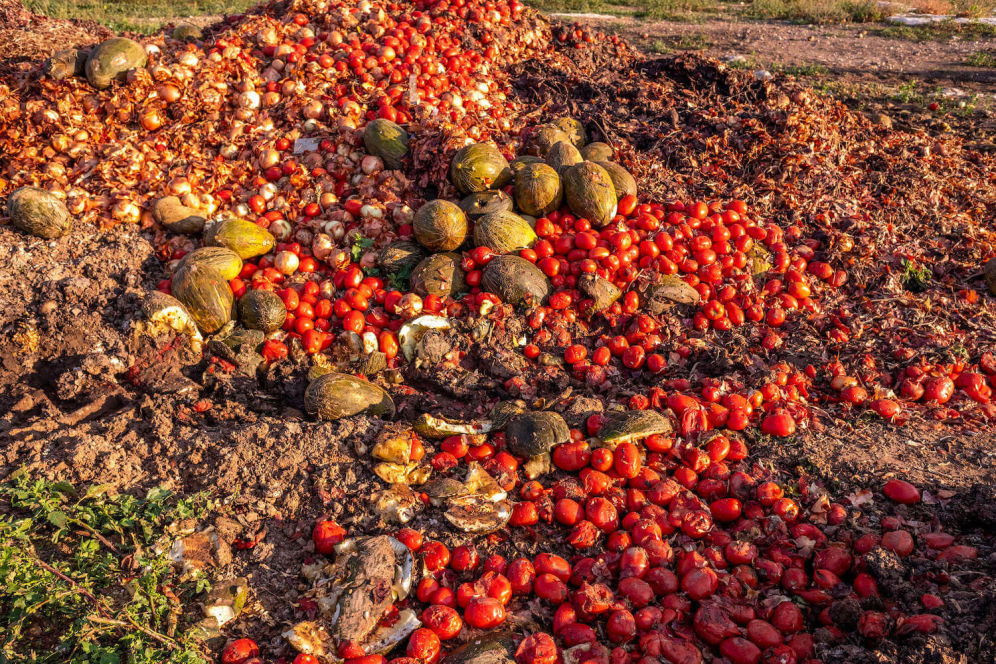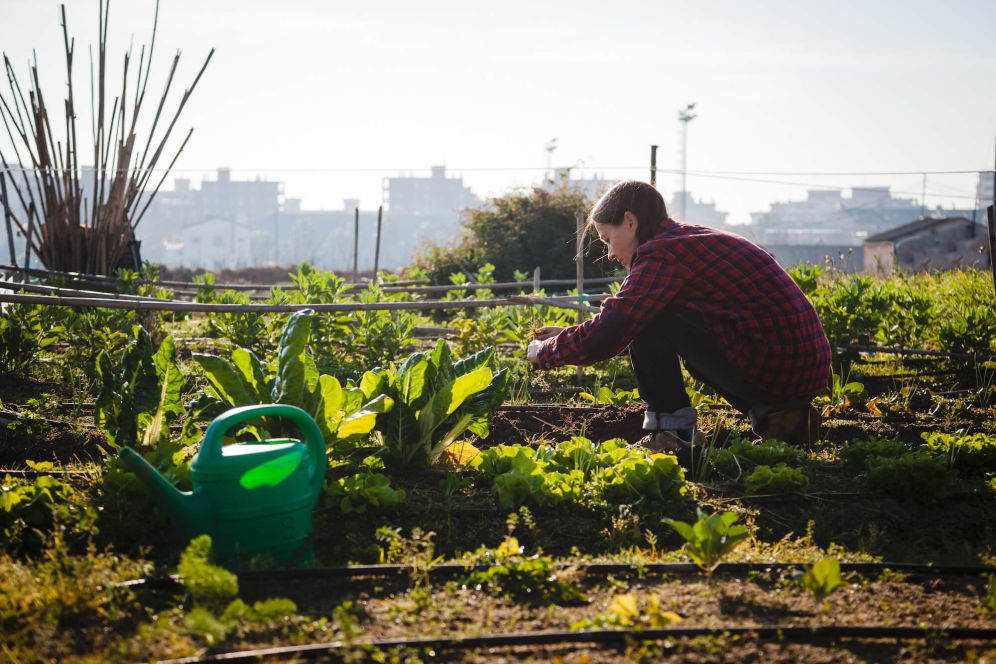The global food system currently accounts for a third of greenhouse gas emissions. A circular economy for food could almost halve these. As the consumers of three quarters of all natural resources, cities can drive the transformation.
American economist Edward Glaeser is famously quoted as saying: “Great cities are not static, they constantly change and take the world along with them,” highlighting both their significant impact and ability to drive global transformations. Such catalytic change is now needed to tackle the climate crisis, and cities are uniquely placed to turn one particularly problematic sector – food – into a solution space.
Food and climate change are fundamentally linked. Although we must switch to renewable energyrenewable energyEnergy derived from resources that are not depleted on timescales relevant to the economy, i.e. not geological timescales. to meet climate targets, it can only address 55% of emissions. To reach net zero, we need to change the way we make and use things, and that includes food. From production to consumption, packaging to shipping, food is responsible for one third of anthropogenic greenhouse gas emissions (GHGs).
Harmful impacts are not limited to GHGs. Converting natural ecosystems into agricultural land, and conventional farming practices have made food production one of the leading causes of biodiversity loss. Those practices play a major role in pollution, and affect citizens. As well as the polarised problems of obesity and malnutrition that arise from our food system – poor diet is said to be responsible for more deaths than smoking – the way we produce food is damaging human health. Overall, for every dollar spent on food, society pays two in health, environmental, and economic costs.

While the industrial food system has evolved to feed a growing global population, its linear nature is at the heart of the problem: take, make, waste. By straining against nature, the food system relies on massive amounts of chemical inputs, water, and fossil fuel energy to make, process, and distribute food. Many of these resources, including land, water, and soil, are finite, and are being run down as we place intense pressure on them to feed eight billion mouths.
Factors such as population growth, land degradation, and changing consumption patterns are pressuring agricultural lands to expand. But 38% of the global land surface is already used for farming, and agriculture uses approximately 70% of global freshwater. Conventional agriculture is reaching its limits.
Despite these gargantuan efforts to produce food, athird of food is wasted. Every second the equivalent of six garbage trucks of edible food is thrown away, often in landfills where it emits harmful methane as it degrades.

There is another way. Food is part of nature, which is inherently regenerative. In a circular economycircular economyA systems solution framework that tackles global challenges like climate change, biodiversity loss, waste, and pollution. It is based on three principles, driven by design: eliminate waste and pollution, circulate products and materials (at their highest value), and regenerate nature., food production regenerates rather than degrades the environment, edible food and by-products are circulated, and all people have access to healthy and nutritious food.
Food is at the forefront of climate action
Although currently part of the problem, our food system represents a huge opportunity to tackle climate change, and the circular economy is a pathway to the change we need. A circular economy applied to the way we produce and manage food resources could cut emissions by 49% (56 billion tonnes of CO2e) in 2050, reduce the impact on farm-level biodiversity by an average of 50% by 2030, and feed our growing population without depleting nature. As a result, food system reform has come to the forefront of the climate debate.
The UN set an ambition to halve per capita food waste and losses globally by 2030 in the Sustainable Development Goals. The Glasgow Food and Climate Declaration, launched at COP26, united 100 sub-national and local authorities to encourage national governments to take joined-up action on food and climate. Agriculture and its impact on the climate crisis has subsequently been named as one of the key focus areas at the upcoming COP27 in Egypt.
Recognising this, the policy landscape is moving to support food system transformation. A conducive policy environment will be instrumental in rapidly scaling the uptake of a circular food system as well as enhancing the effectiveness of existing initiatives.
At city-level, political momentum is building. Milan’s efforts to mitigate climate change through its food system – one of Europe’s most innovative and holistic urban food policies – won the city the inaugural Earthshot Prize. São Paulo has made food central to its climate strategy: PlanClima SP. London has identified food as a major opportunity to decrease consumption-based emissions. Guelph-Wellington is committed to creating Canada’s first circular food economy, which promotes collaboration between all food stakeholders and leverages technology to make it possible. All use the circular economy framework.
Cities can lead the transformation
By 2018, more than half the world’s population lived in cities (a number expected to keep climbing). Cities consume over 75% of natural resources, are responsible for over 50% of global waste, and emit up to 80% of global greenhouse gases. It is projected that 80% of all food will be consumed in cities by 2050. They are black holes sucking in food and resources.
Yet, with that appetite comes influence and opportunity – both environmental and economic. Consumer demand for products that are nutritious and good for nature is already a promising business opportunity. Organic food and drink sales reached USD 129 billion in 2019 and Unilever’s Sustainable Living Brands grew 69% faster than the rest of its business.
Harnessing these consumption hotspots and setting them on a circular course has the power to trigger the shift towards a circular, regenerative system fit for the long term. Cities can rapidly reduce food waste, drive demand for regeneratively produced food, and foster innovation – as is being shown by a handful of those already employing circular economy strategies.

In recent years many municipalities have been able to dramatically improve organic waste collections, cutting harmful emissions in the process. By redistributing food, encouraging consumers to use food close to its sell-by date, improving organic waste collection and compostingcompostingMicrobial breakdown of organic matter in the presence of oxygen. infrastructure, and other measures, cities have been able to drive down their food waste. Such successful schemes offer other cities a range of recipes for reducing their own waste.
Agricultural practices that have regenerative outcomes for nature – often referred to as regenerative agriculture, but also capturing activities such as agroecology, agroforestry, and conservation agriculture – are among the most powerful tools for reducing emissions from the food system, allowing farmers to move from carbon reduction to carbon sequestration. According to technology company Indigo Ag, if the organic matter content of all the world’s farmland were increased from a current average of 1% to a pre-industrial level of about 3%, the effect would be to soak up 1 trillion tonnes of carbon – equivalent to all industrial emissions produced since the Industrial Revolution.
Cities have begun to successfully stimulate a shift to regenerative agriculture. By creating a demand for regeneratively grown produce and offering subsidies to growers, cities can create a market that makes it worthwhile for farmers to switch methods. In São Paulo, the municipality buys regeneratively grown produce from farmers at 30% more than market value, which has already seen 40% of farms in the project fully convert from conventional to organic farming.

Cities are hives of economic growth and vital centres of culture, innovation and learning and so are well placed to connect all actors in a system and pioneer solutions. By drawing on these reserves of creativity and actively stimulating innovation, cities can develop disruptive solutions to food challenges. To counter the need for new agricultural land, for example, salad leaves and vegetables are grown underground in London. In Phoenix eggshells are collected from local restaurants and hotels and upcycled into pet treats, to rescue them from landfills and compost heaps. In Tel Aviv, dairy milk is being created without cows.
By actively incubating innovation through incentives and support, cities can encourage designers, entrepreneurs and academics to rethink the food system and uncover creative new solutions to accelerate the transition to a circular food system.
Significantly reducing emissions will be challenging and will require everyone to act. The consumption habits of billions of people need to change, so do the production habits of hundreds of millions of producers, and long and complex food supply chains need to be decarbonised.
Public and private investment will be vital too. The World Bank suggests that the cost of this food system transformation will run to about USD 300-350 billion annually for the next 10 years but, given that that climate change adaptation costs are expected to range from USD 140 billion to 300 billion per annum by 2030, rising to USD 280-500 billion per annum by 2050, that’s not an unreasonable investment. As the International Food Policy Research Institute (IFPRI) highlights, ‘investing in food systems transformation is a key piece of the climate change puzzle’.
Finding solutions that can cut these hard-to-reduce emissions will be critical in meeting climate targets. Cities are a good place to start.
With thanks to the following experts and cities for their contributions:
Tansy Robertson-Fall, Senior Editor, Ellen MacArthur Foundation
Sarah O’Carroll, Cities Lead, Ellen MacArthur Foundation
Josh Newton, Europe Cities Activation Manager, Ellen MacArthur Foundation
Reniera O’Donnell, Food Initiative Lead, Ellen MacArthur Foundation
Henrietta Goddard, Research Analyst – Food Initiative, Ellen MacArthur Foundation
Greater London Authority and ReLondon, Cidade de São Paulo, Comune di Milano, City of Guelph, City of Phoenix, Glasgow Chamber of Commerce





